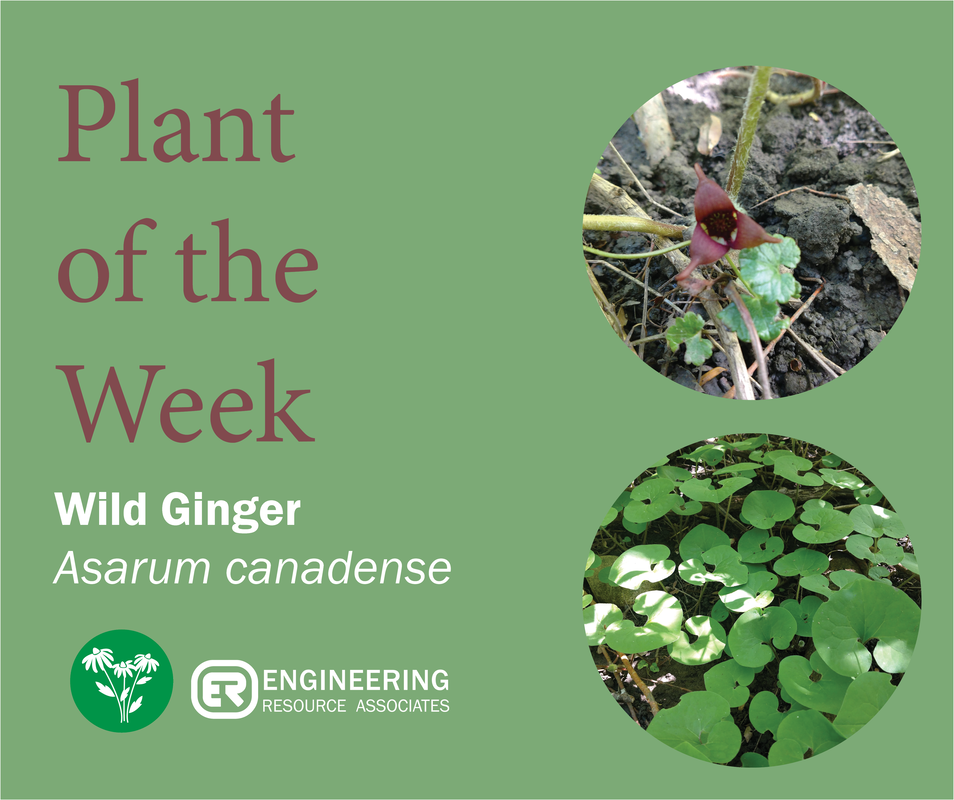This week’s featured plant is Asarum canadense, also known as Wild Ginger!
Wild ginger is a low growing ground cover plant in the Aristolochiaceae family of pipevine plants known for their highly unusual flowers. Wild ginger is easily identifiable by its heart-shaped fuzzy leaves that seem to glimmer in sunlight and an unusual looking small red flower that grows out of the leaf base and droops to the ground. Found mostly on dry to slightly moist woodland slopes, this plant can form dense colonies on the forest floor below a traditional open canopy of oak, sycamore, and hickory.
There is not a single most interesting aspect of this plant, from the interesting foliage to the unusual flower, wild ginger also serves as a substitute to traditional ginger (Zingiber officinale) from southeast Asia. The fragrant rhizome can be used fresh or dried and ground into a powder to impart flavor into cooking. Just as fascinating is this plant’s approach to reproduction. Unlike many other flowers, A. canadense does not attract pollinators with sweet fragrances and the allure of nectar, but instead chooses to attract beetles and flies using the scent of decaying flesh. This is a trait commonly associated with the gargantuan century plants, often featured in many botanic gardens (Amorphophallus titanium). With beetles as the primary pollinator, this is only one of the reasons the flowers droop to the ground. Once the flower is pollinated, the seeds develop and the pod splits, revealing seeds with a fleshy coating similar to that of species in the Trillium genus. This bit of food is then carried away by ants with the seed still attached, where it will germinate away from the parent plant and begin a new colony of Ginger.
Wild ginger is a low growing ground cover plant in the Aristolochiaceae family of pipevine plants known for their highly unusual flowers. Wild ginger is easily identifiable by its heart-shaped fuzzy leaves that seem to glimmer in sunlight and an unusual looking small red flower that grows out of the leaf base and droops to the ground. Found mostly on dry to slightly moist woodland slopes, this plant can form dense colonies on the forest floor below a traditional open canopy of oak, sycamore, and hickory.
There is not a single most interesting aspect of this plant, from the interesting foliage to the unusual flower, wild ginger also serves as a substitute to traditional ginger (Zingiber officinale) from southeast Asia. The fragrant rhizome can be used fresh or dried and ground into a powder to impart flavor into cooking. Just as fascinating is this plant’s approach to reproduction. Unlike many other flowers, A. canadense does not attract pollinators with sweet fragrances and the allure of nectar, but instead chooses to attract beetles and flies using the scent of decaying flesh. This is a trait commonly associated with the gargantuan century plants, often featured in many botanic gardens (Amorphophallus titanium). With beetles as the primary pollinator, this is only one of the reasons the flowers droop to the ground. Once the flower is pollinated, the seeds develop and the pod splits, revealing seeds with a fleshy coating similar to that of species in the Trillium genus. This bit of food is then carried away by ants with the seed still attached, where it will germinate away from the parent plant and begin a new colony of Ginger.

